 General Information
General InformationGreen Roofs
Rainwater Harvesting
Ponds and Wetlands
Energy-Efficient Building
Design Principles
Weatherseals
Pricelist
Corner-Grooving System
Caulkable Cornerseals
Adjustable Door Bottom
Automatic Door Bottom
Jamb Seals
Bottom Seals
Center Seals
Sliding Seals
Techniques
Building Gaskets
Glazing Gaskets
Timber Glazing
Air-Vapor Films
Attic Access
Ventilation
Sealants
Shim Screws
Wood Repair
Documents
Waterproofing

WEATHERSEALS: SLIDING SEALS
The following drawings show seals used at the jambs and meeting rails of double-hung windows, or on all sides of sliding windows and doors. For compression seals at the top and bottom of double-hung windows, see Bottom Seals.
In general, designs that seal between the exterior face of the window or door and the exterior stop are best. Brushseals are recommended where surfaces are smooth and gaps are uniform. Leafseals work well with rougher surfaces and non-uniform gaps. For compression
Symbols show the direction of motion of the door or window as it slides open. The cross within a circle indicates sliding motion between the stops, or toward the viewer. The arrow indicates motion away from the stops. Many designs work for both motions.
SLIDING SEALS AT EDGES: In the first set of drawings, "jamb" could represent the side jamb of a vertically sliding window or door, or the header jamb of a horizontally sliding window or door.
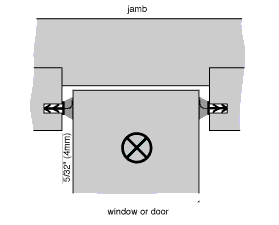
WS75 IN STOPS
Cut 1/8" x 1/4" (3mm x 6mm) grooves in the
stops. Design for a 5/32" (4mm) gap to fit
WS75: if the fit is too tight, substitute WS74 (for
1/8" or 3mm gaps); if it is too loose, substitute
WS76 (3/16" or 5mm gaps). The best seal
results when the brush is only slightly bent.

WS62 IN WS40 IN STOPS
Nylon brushes are recommended for heavy-duty
sliding seals for large sliding windows and doors,
including overhead doors. Cut 3/16" x 9/32"
(5mm x 7mm) wide groove in the edge of the
stops for WS40 channel. The best seal results
when the brush is only slightly bent.
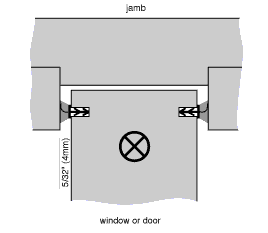
WS75 IN FACE OF SASH
Cut 1/8" x 1/4" (3mm x 6mm) grooves in the face of
the window or door. Design for a 5/32" (4mm) gap
to fit WS75: if the fit is too tight, substitute WS74
(for 1/8" or 3mm gaps); if it is too loose, substitute
WS76 (3/16" or 5mm gaps). The best seal results
when the brush is only slightly bent.
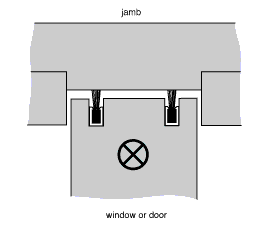
WS62 IN WS40 IN SASH EDGE
Cut two 3/16" (5mm) wide grooves in the edge
so that the depth of the grooves added to the
gap at the edge totals 1/2" (13mm). For
example, if the edge gap were 1/8" (3mm), the
groove depth would be 3/8" (10mm). The jambs
must be nearly parallel to prevent binding.
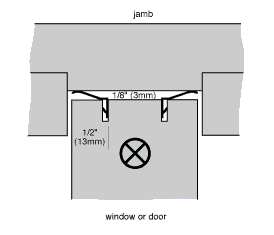
WS84 IN SASH EDGE
Cut two 5/64" x 5/16" (2mm x 8mm) grooves in
the edge. The gap between the window or door
and the jamb can be 1/16" – 3/16" (2mm – 5mm),
but design new work for 1/8"– 5/32" (3mm – 4mm).
Shift the grooves slightly and substitute WS83 for
gaps up to 1/4" (6mm).
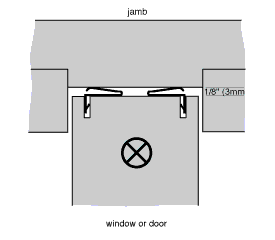
WS86 IN SASH EDGE
Cut two 5/64" x 5/16" (2mm x 8mm) grooves in
the edge. The gap between the window or door
and the jamb can be 1/16" – 3/16" (2mm – 5mm),
but design new work for 1/8" – 5/32" (3mm – 4mm).
Substitute WS87 for gaps up to 1/4" (6mm).
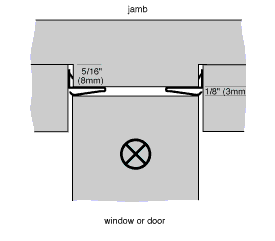
WS86 IN JAMB
Cut the dados for the stops 5/64" (2mm) wider
than needed. The gap between the window or door
and the jamb can be 1/16" – 3/16" (2mm – 5mm).
Substitute WS87 for gaps up to 1/4" (6mm). Note
that the leafseals block air flow behind the stops.
SLIDING SEALS AT CENTERS: The next set of drawings show methods for sealing meeting rails of double-hung windows, or center stiles of sliding windows and doors.
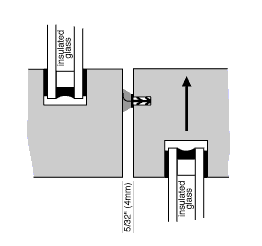
WS75 IN FACE AT MEETING RAIL
Cut a 1/8" x 1/4" (3mm x 6mm) groove in one
face and insert WS17. Brushseals WS78 or
WS62 in WS40 can seal the same range, but
these are not as forgiving with uneven gaps.
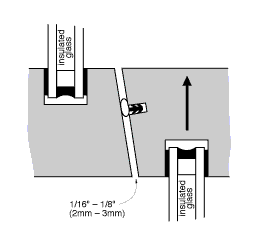
WS32 IN FACE
Cut a 1/8" x 1/4" (3mm x 6mm) groove in one
face. WS32 can fit gaps as small as 1/16" (2mm).
If gaps are larger, substitute WS33, WS34, WS35,
or WS36. Note the angled meeting surfaces
which are important to avoid excessive rubbing
and pinching of the silicone weatherseals.
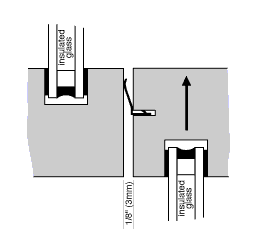
WS84 IN FACE
Cut a 5/64" x 5/16" (2mm x 8mm) groove in one
face and insert WS84. The gap between the two
windows or doors can be 1/16" to 3/16" (2mm –
5mm) but design new work for 1/8" to 5/32"
(3mm – 4mm). Substitute WS83 when gaps are
larger (up to 1/4" or 6mm).
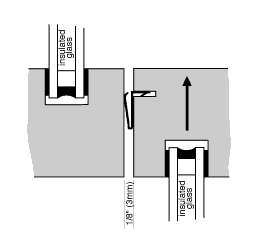
WS86 IN FACE
Cut a 5/64" x 5/16" (2mm x 8mm) groove in one
face and insert WS86. The gap between the two
windows or doors can be 1/16" to 3/16" (2mm –
5mm) but design new work for 1/8" to 5/32"
(3mm – 4mm). Substitute WS87 when gaps are
larger (up to 1/4" or 6mm).

WS17 IN FACE
Cut a 1/8" x 1/4" (3mm x 6mm) groove in one
face and insert WS17. Brushseals WS78 or
WS62 in WS40 can seal the same range, but
these are not as forgiving with uneven gaps.
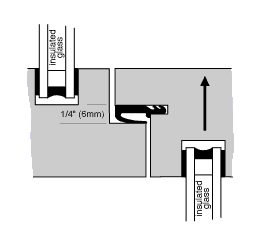
WS16 IN RABBETED OVERLAP
Cut a 1/8 " x 1/4" (3mm x 6mm) groove in the
corner of one of the rabbeted edges and insert
WS16. If there is enough wood to prevent
splitting, the groove could be cut parallel to the
direction of motion and WS11, WS14, or WS15
could be used instead.

WS36 IN RABBETED OVERLAP
Cut a 1/8" x 1/4" (3mm x 6mm) groove at a 45°
angle in the corner of one of the rabbeted edges
and insert WS36. This groove can be easily cut
with a WS98 Corner Grooving Machine. Where
grooving is not possible, substitute WS06 and
caulk it in place.